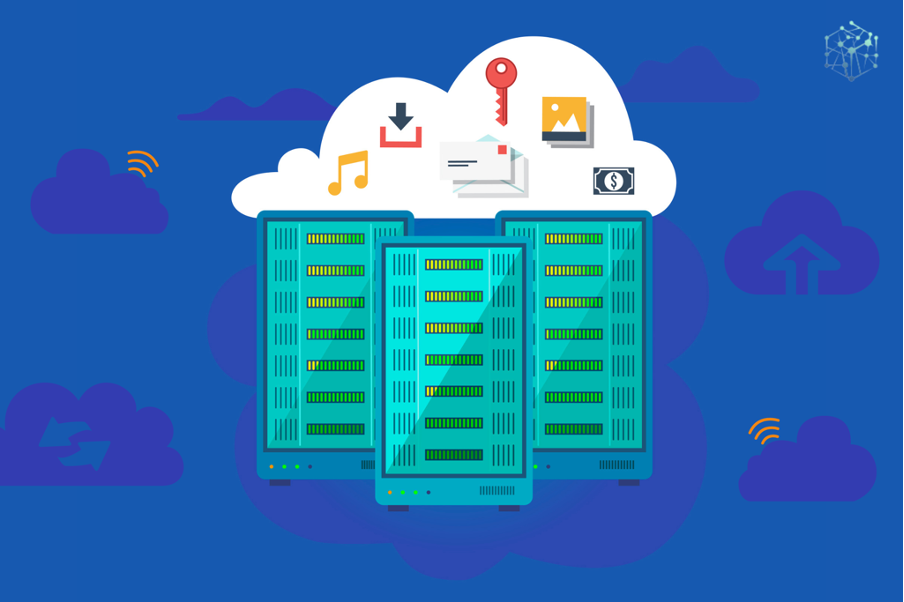Navigating the Data Storage Landscape: A 2023 Guide to Cloud and On-Premise Solutions

In today's rapidly evolving digital world, businesses must navigate an ever-changing landscape of data storage options. As we enter 2023, the need for efficient and secure data storage solutions is more critical than ever. This guide will explore the various types of storage solutions available, compare cloud and on-premise storage, and provide valuable insights into the top cloud service providers. By the end of this article, you'll be equipped with the knowledge to make an informed decision on the best storage solution for your business.
Understanding Different Types of Data Storage Solutions
Cloud Storage
Cloud storage has become an increasingly popular choice for businesses in recent years, and for good reason. This type of storage involves storing data on remote servers, which can be accessed via the internet. By leveraging cloud storage, organizations can take advantage of a scalable and cost-effective solution that can grow with their needs. Additionally, cloud storage providers typically handle the maintenance and management of the infrastructure, freeing up valuable time and resources for businesses.
On-Premise Solutions
On-premise storage solutions involve businesses maintaining their data storage infrastructure on their own premises, either through physical servers or dedicated data centers. While this approach provides greater control over the infrastructure and security, it also requires significant upfront investments in hardware and ongoing maintenance costs. Additionally, because of potential capacity restrictions imposed by the physical infrastructure in place, on-premise storage solutions may be less flexible than cloud storage options.
Comparing Cloud and On-Premise Storage: Key Differences
When evaluating whether cloud storage or on-premise solutions are the right fit for your business, it's essential to understand the key differences between the two options.
First and foremost, cloud storage offers greater scalability, as it allows you to easily add or remove storage capacity as needed. This flexibility enables businesses to only pay for what they use, which can result in cost savings over time. On the other hand, on-premise solutions require upfront investments in hardware and ongoing maintenance costs, which can be limiting for smaller businesses or those with fluctuating storage needs.
Secondly, cloud storage often provides more robust data protection and disaster recovery options. Cloud service providers typically maintain multiple data centers in different geographic locations, which can help protect against localized outages or disasters. In contrast, on-premise solutions may be more vulnerable to such events, as businesses are responsible for managing their own backup and recovery procedures.
Finally, security concerns are a critical consideration when comparing cloud and on-premise storage solutions. While both options can provide robust security measures, cloud storage providers often have access to more advanced technology and expertise to protect against threats. However, businesses must carefully evaluate the security measures in place with any cloud provider to ensure their data is adequately protected.
Cloud Storage Solutions
Public Cloud
Public cloud storage refers to services provided by third-party providers, such as Amazon Web Services (AWS), Microsoft Azure, and Google Cloud. These providers offer a variety of storage services, including object storage, file storage, and block storage, catering to different use cases and requirements. Public cloud storage is typically more cost-effective than other cloud storage options, as it allows businesses to access shared resources on a pay-as-you-go basis.
Private Cloud
Private cloud storage involves dedicated storage infrastructure that is not shared with other organizations. This option provides greater control over data and security, making it ideal for businesses with stringent compliance requirements or those that handle sensitive information. However, private cloud storage can be more expensive than public cloud storage, as it requires dedicated hardware and management resources.
Hybrid Cloud
Hybrid cloud storage combines the best of both worlds by leveraging both public and private cloud resources. This approach allows businesses to take advantage of the scalability and cost savings of public cloud storage, while still maintaining control over sensitive data and applications through private cloud resources. Hybrid cloud solutions often involve using on-premise private cloud infrastructure in conjunction with public cloud services, providing flexibility and security.
Top Cloud Service Providers
Amazon Web Services (AWS)
AWS is a leading cloud service provider, offering a wide range of storage services, including Amazon S3, Amazon EBS, and Amazon Glacier. With a significant market share, AWS provides a reliable and scalable solution for businesses of all sizes. Additionally, AWS offers a comprehensive suite of tools for data management, machine learning, and analytics.
Microsoft Azure
Microsoft Azure is another top cloud service provider, offering a variety of storage solutions, including Azure Blob Storage, Azure Files, and Azure Disk Storage. Azure also provides a wide range of tools and services for data management, analytics, and machine learning, making it an attractive option for businesses already using other Microsoft products.
Google Cloud
Google Cloud rounds out the top three cloud service providers, offering storage solutions such as Google Cloud Storage, Persistent Disk, and Filestore. Like AWS and Azure, Google Cloud provides a suite of tools and services for data management, analytics, and machine learning. Google Cloud is well-regarded for its innovation and commitment to open-source technologies, making it a popular choice for businesses looking to leverage cutting-edge solutions.
Navigating Cloud Storage Costs and Cost Optimization
One of the main benefits of cloud storage is the potential for cost savings compared to on-premise solutions. However, it's essential to understand the various factors that contribute to cloud storage costs and how to optimize them.
Cloud storage costs are typically based on a combination of factors, including the amount of storage used, the type of storage service, data transfer, and the number of requests made to the storage service. To optimize costs, businesses should carefully consider their storage needs, choose the appropriate storage service, monitor usage regularly, and implement cost-saving measures such as data compression or tiered storage.
Another critical factor in optimizing cloud storage costs is selecting the right pricing model. Many cloud service providers offer various pricing options, including pay-as-you-go, reserved instances, and spot instances. Each pricing model has its own advantages and disadvantages, depending on the business's storage needs and usage patterns.
Businesses should also consider other cost-saving measures when using cloud storage, such as taking advantage of discounts offered by cloud providers or using cloud storage for backup and archival purposes, which can be less expensive than using it for primary storage.
Data Management and Protection in Cloud Storage
Data management and protection are critical considerations when using cloud storage solutions. While cloud service providers offer robust security measures, businesses are ultimately responsible for ensuring their data is adequately protected.
Data Protection
Data protection in cloud storage involves a variety of measures, including encryption, access controls, and backup and recovery procedures. Businesses should carefully evaluate the security measures provided by their cloud service provider and implement additional security measures, such as multi-factor authentication or data encryption, as needed.
Data Centers and Infrastructure
Cloud service providers maintain multiple data centers in different geographic locations, which can help protect against localized outages or disasters. Businesses should evaluate the locations of their data centers and ensure they are adequately protected against physical and cyber threats.
Disaster Recovery
Disaster recovery is a critical consideration for businesses using cloud storage solutions. Cloud service providers typically offer robust disaster recovery options, such as data replication, data snapshots, and backup and recovery procedures. Businesses should carefully evaluate the disaster recovery options provided by their cloud service provider and implement additional measures, such as off-site backups or redundant infrastructure, as needed.
Security Concerns in Cloud Storage and On-Premise Solutions
Security is a top concern for businesses using both cloud storage and on-premise solutions. While cloud service providers offer robust security measures, businesses must carefully evaluate the security measures in place and implement additional measures as needed.
On-premise solutions provide greater control over security, as businesses maintain their own infrastructure and can implement their own security measures. However, on-premise solutions can be vulnerable to physical threats, such as theft or natural disasters.
Cloud storage solutions offer advanced security measures, such as data encryption, multi-factor authentication, and access controls. However, businesses must carefully evaluate the security measures provided by their cloud service provider and implement additional measures, such as data encryption or data backup, as needed.
Choosing the Right Storage Solution for Your Business
When choosing a storage solution for your business, it's essential to carefully evaluate your needs, budget, and security requirements. Consider factors such as scalability, cost, data protection, and disaster recovery options when evaluating cloud and on-premise solutions.
Businesses should also carefully evaluate cloud service providers, considering factors such as pricing, features, reliability, and security. Additionally, businesses should consider factors such as the provider's commitment to innovation and open-source technologies when evaluating cloud service providers.
Conclusion and Future Outlook of Data Storage
In conclusion, navigating the data storage landscape in 2023 requires careful consideration of the different types of storage solutions available, including cloud and on-premise solutions. While cloud storage offers scalability and cost savings, on-premise solutions provide greater control over security and infrastructure.
When choosing a storage solution for your business, carefully evaluate your needs and consider factors such as scalability, cost, data protection, and disaster recovery options. Additionally, evaluate cloud service providers based on factors such as pricing, features, reliability, and security.
Looking to the future, the data storage landscape is likely to continue evolving rapidly, with advancements in technologies such as machine learning and the continued growth of cloud computing. By staying informed and making informed decisions, businesses can take advantage of the latest storage solutions to drive digital transformation and cost savings.
Learn more about our cloud storage solutions and how we can help your business achieve its storage goals.
